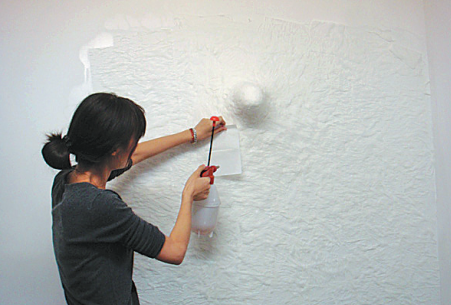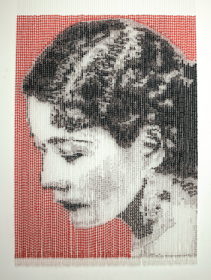Artist gives birth to hair apparent
Arrival of daughter changes life for mother who turns to an unusual form of expression, Wang Qian reports.

Before giving birth to her first child in 2012, Cai Yaling had no clue how tough being a mother would be, nor of the expectations society place upon women. A lot happened in a short space of time. In 2011, just a year or so previously, she had got married and then, after earning her master's degree in sculpture at the China Central Academy of Fine Arts in Beijing, fell pregnant. Cai didn't realize at the time that her career as an artist would face a two-year hiatus due to motherhood. When she did, depression and a sense of isolation set in.
"Trapped in depression, I couldn't figure out who I was but a mother. My previous life seemed like another life. My daily routine was to breastfeed my daughter or put her to sleep," the 37-year-old artist recalls.
She wanted to tell her story. But mobility, both social and actual, was difficult because of the demands of motherhood, so she turned to something ordinary to make an extraordinary statement-her hair. She used it to tell of the struggle unfolding inside. Like most mothers in China, she had it cut before giving birth, to prepare for the traditional custom of zuoyuezi ("sitting the month"). During the postpartum month, according to Chinese tradition, certain rules are followed, such as keeping warm, not showering or washing your hair, for the benefit of mother and child.
"When I held my hair in hands, I started wondering what I could do with it. Out of instinct, I began to sew the hair on a white cloth," Cai says. Every day, she sewed for about half an hour. The process lasted for about two years.
Titled Aug 21, 2012 to mark her daughter's birthday, her hair became an artwork. Sewed into a spiral, a symbol of infinity, its roundness indicates the pregnant belly and a symbol of fertility, according to Cai.
For the artist, the concentration demanded by the needlework helped her calm down and ease her anxiety enough to be able to face up to the change in her life and struggle to catch up with her new identity. She has tried to explore this struggle through art.
"It opened a distinctive phase for my creativity, which was to use my own hair to create artworks that are closely related to my life experience," Cai says, adding that the medium shares a sense of intimacy.
Experiencing childbirth made the artist really understand how much pain a mother must go through to bring a baby into this world and, as such, her art started to highlight women as a group as opposed to focusing on personal experiences.
"After the terrible delivery process, you still have a long way to go, such as dealing with the change in hormones and body shape, postpartum depression and lack of sleep," she says.
Like Aug 21, 2012, Cai's artworks try to explore the intimate relationship between motherhood and life. She has won several top awards, including the Annual Emerging Artist of the Signature Art Prize China 2019, the Prix YISHU 8 China and 2017 Lalique Nova Art Prize.
Breaking stereotypes
Born in 1984 in a town in North China's Shanxi province, Cai was raised in a traditional family where women were obedient and hardworking, putting family first.
"Before getting married, I didn't notice much of a difference between men and women and thought that I could do anything that I wanted to. But, becoming a wife and a mother has made me realize how many identities a woman has in her life, and what the cost is," Cai says. There's a point where traditional virtues for women can become barriers, she adds.
For her mother's generation, women take all these responsibilities without much complaint, but for Cai, her reflection on a woman's role in family and society inspired her art.
Following Aug 21, 2012, the artist began to look at her relationship with her mother in a different way, inviting her to participate in the creation of more pieces, which has seen them grow closer during the process.
"My mother has a habit of pulling out white hairs as her way of fighting against the march of time, which makes me feel sad. I came up with the idea to sew her white hair down on a black cloth with painted polka dots, and my black hair on a white cloth," Cai says.
Polka dots were chosen, she says, because one of her favorite shirts of her mother's is pink with black polka dots. For Cai, she saw the day that she herself could wear that shirt as the milestone moment marking her transition to adulthood.
The two pieces are named Polka Dot-White and Polka Dot-Black, exploring intergenerational womanhood.
"I want to record and restore my mother's white hair, which has witnessed her younger days, her efforts and hardships in life," Cai says.
After the polka dot series, in 2016, Cai and her mother created another two-piece work: Me, 1987, using Cai's black hair sewn into polka dots on a cloth with a photo of her at the age of 3 taken in 1987; and Mother, 1987, using her mother's white hair to sew waves on a cloth printing of a photo of the mother taken in the same year.
"The set is about a dialogue beyond time and space," Cai says.
Besides the relationship with her mother, her daughter has also inspired her. There are few things in the world that hurt a parent more than hearing their child say: "Mom, I don't like you anymore."
When her own daughter said those words, Cai was sad and the words were like a dagger plunged into her heart. She carved the Chinese characters out of wood to form the sentence and charred them until they turned black. The burnt wooden words form the resultant artwork.
"The charring process has removed the wood's life and energy, reflecting what I felt after hearing my daughter's words," Cai says.
Female power
In 2015, Cai had her second child, a son. Taking care of two children actually made her feel more depressed and pressured than her first child.
Every day she would ask herself:"Where am I? Who can hear my voice? Where is my future?" At night, she would encourage her reflection in the mirror to believe in herself, urging it to "not stop pursuing your dreams".
From Cai's own experience, when a woman goes back to work after childbirth, the requirement of society is higher. They cannot win. At home, their families expect them to be devoted mothers as if they have no job, while in the workplace, mothers are supposed to work like they do not have children.
"Maybe many people take it for granted, but I think it is not right, and I want to express my feelings,"Cai says.
She created a series of beaded curtains emblazoned with words and phrases frequently uttered by her female friends, such as "leave me alone" and "no".
"Beaded curtains feel similar to a fast-paced society in which everyone gets used to controlling their emotions. These feelings hide deep inside, and once touched, they will suddenly burst forth," the artist explains.
Cai hopes that she can express the pressure and confusion faced by most people, especially women, through her installations.
This year, her installation Red Sea was built in cooperation with dozens of other women, who are factory workers, using more than 100,000 crystal beads to create a giant tidal wave.
During the process, she talked with these women and found out that, although each of them has encountered various difficulties, they always keep smiling and try hard to make a better life. "It's like an invisible wave under the water. But the tide will finally come," according to Cai.
Giving up being a "good enough" mother herself, Cai knows that there is no work-life balance. Last year, after her son started kindergarten, she went back to her alma mater to continue her studies and earn a doctorate.
"I do not know what a mother I will become, but as a female artist, I know what I want to do-I want to record women's voices, let them be heard and inspire even more of them," Cai says.
When Cai's daughter says that she wants to become an artist like her, Cai knows that her efforts are working.



Today's Top News
- China bids to cement Cambodian-Thai truce
- Fiscal policy for 2026 to be more proactive
- Revised law to spur high-level opening-up
- High-speed rail mirror of China's modernization
- China will deliver humanitarian aid to Cambodia
- The US 2025: a year of deep division






























